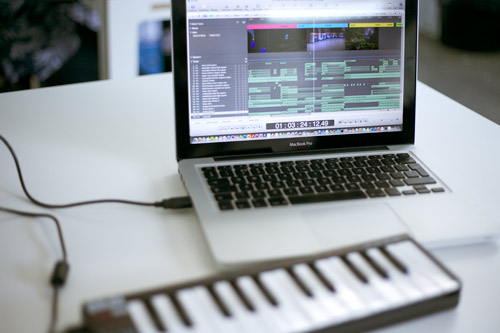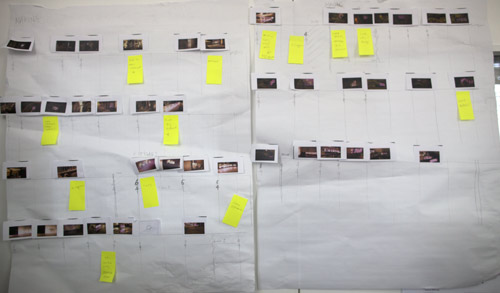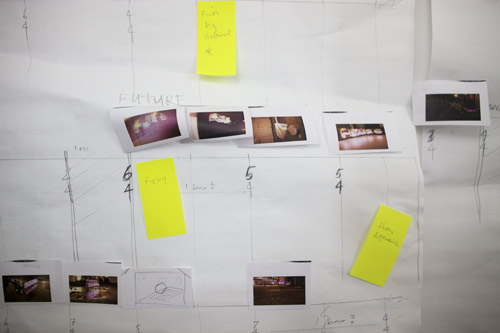Some of you might have seen this film we released with our friends from Dentsu London the other day. At the time of writing, it’s had over half a million views. Whoa.
Also, a few people have been asking about the music we used, so I thought I’d chat a little bit about it. We wrote it ourselves, here in the studio. I pasted it all together, with direction and input from Schulze, Timo, Beeker and the rest of the Dentsu crew.

Some of the best bits about working at BERG are how everyone, despite having particular specialist skills, gleefully ignores boundaries, disciplines, labels and predefined processes, and allows themselves space to just run with things when they get excited. Deciding to do the music for the first Making Future Magic film ourselves was one of those moments.
“Yeah, so who are your influences then?”
About ten days ago, after the animation had reached a final(ish) edit, I happened to overhear Schulze, Timo and Cam batting a few ideas around about potential soundtrack music. I hadn’t really been involved in the project so far, but at this point I dropped what I was doing, went a bit Barry from High Fidelity, and started throwing some MP3s at them.
Over that afternoon, we chewed on some of Aphex Twin’s prepared piano robotics; the sinister, codeine-fuelled fizzes of Oneohtrix Point Never; the anodyne, bleepy piano washes of Swod and Jan Jelinek; the fuzzy felt collages of The Focus Group; the tranquil-yet-demented drone of Mandelbrot Set; Finnish free jazz kraut-metallers Circle; ultra-hip dub-glitchers Mount Kimbie; the electric guitar symphonies of Glenn Branca; some Eno-squelched dulcimer by Laraaji; downright weirdness by Basil Kirchin, and of course the obligatory Reichs, Glasses and Rileys. Maybe a dash of Yellow Magic Orchestra at the end, too, just for sheer melodic charm and natty suits.
That weekend, on a long train journey, and with a few hours to kill, I was listening back to the tunes we’d picked out, and thought I’d sketch out some musical ideas to accompany a few clips of the current edit, just as a little exercise. Like loads of people I know, I do enjoy a bit of noodling around with things like Ableton Live, Logic, Beatmaker on the iPhone and so on. So I had a crack at it.
On the Monday morning, everyone had a listen, and nudged me to do a little more, just to see where it went. Gradually, things began to firm up into a “proper job”. I’d never written music for a film (or anything else, for that matter) ever before, but hey, everyone knows the best way to learn something is simply to set a risky week-away deadline involving potential public ridicule. So here went nothing.
Designing the Music – first sketches
We all know that a lot of the unseen (yet most satisfying) work in design goes into getting rid of things. Tidying up. Wielding Occam’s Razor. Making things unnoticeable. Getting things under the hood working so well you forget they’re there. All that good stuff. There are obvious parallels to this in music, but I guess this applies even more so to making soundtracks.
Not your rousing, whistle-able belters of your Williamses or Morricones; I’m thinking more about Bernstein’s work for the Eames films, John Cameron’s haunting soundtrack to Kes, anything on the KPM label, or, say, Clint Mansell, whose Moon soundtrack got quite a rinsing here in the studio last year. There’s a quiet unselfishness to this type of music which I’m really drawn to – it’s kind of half-there, beckoning you to invent accompanying stories and pictures in your head, and sometimes it’s at its best when you don’t really notice it. I imagine this rings lots of little bells in the heads of anyone involved in design or making things – it definitely does for me.
As I say, I’d never really written any music before, so pretty much used these little scraps of what I know about design (and what I love about film music) as a way in. Finding the grain of a material and playing with it; hitting on an idea and not getting in the way of it; looking for patterns; making references to other, familiar concepts, using broad brush strokes first, then (quite literally) tuning and polishing – all the usual approaches, really. The same way we’d work with any (im)material here at BERG.
So, here are the three first sketches I did. The visual glitchiness of the animation was the main thing I wanted to complement, so I went outside, made some little field recordings on my phone, chucked them all into the computer, then pressed record and left it on. I assembled the samples into few rhythms, teased out little patterns of pitch, timbre and so on, and eventually, after a few hours, out popped a few bits and pieces. It took me about 6 hours of jamming to come up with three one-minute ideas. Told you I was new at this.
That was a bit Chris Isaak meets Twin Peaks. Bland. Nah. Next.
A po-faced Radiohead rip-off. Cheesy moody piano. Banal drum-and-bass-by-numbers rhythm. Overall, nah.
We all sat up at this one. Warm, bubbly ARPy synths; Reichy scales and patterns; plinky, poppy glockenspiels; pentatonic scales giving off a subtle whiff of J-Pop (which might sit nicely with the Dentsu folks), and it had the most potential to grow melodically. Tick!
Building out the musical structure
After that, it was time to work out how this sketch would evolve to fit across the whole film. The first task was to build the scaffolding we wanted to hang everything off, by translating the timing of each visual cut into bars and beats, which I did with a metronome and a few big sheets of paper. I grabbed Schulze, talked about where we wanted the main narrative pivots to be, and stuck those on post-it notes.


Since we had three sections to work with (Making, Future and Magic), everything pretty much finished itself after that. We’d built the scaffolding, so now all that was needed was the rest of the building – from the main zones down to furniture, textures, colours and so on. I blocked in the main themes and some large areas of texture, then just worked my way down to polishing little details. I don’t know much about how composers work, but this bit wasn’t all that different from we usually get from whiteboards and post-its down to pixels and working code.
Jack and Timo were still making edits to the film as I was composing, so I needed to leave a bit of slack here and there to adjust to their timings. I made little modular loops of different lengths (3, 4, and 5 notes, in different rhythms, at different speeds), which meant I could cut or extend little phrases here and there, ignoring strict time signatures as needed. Again, just simple, common sense stuff, really.
The final mix
After 3 or 4 days of tuning and polishing, we had an overall structure everyone was pretty happy with, so we got in touch with the chaps at Resonate to help us mix and master everything – the proper, detailed tuning. Big big thanks to Liam and Andy for being super helpful at such short notice! Aside from treating a novice like me very kindly, they brought a level of clarity and depth to the mix way beyond what my ears had previously heard. Here are the before and after versions. Spot the difference!
Before mixing:
Mixed and mastered:
And of course here’s the finished film.
Overall, the music took us about 6 or 7 days. A mere blip compared to the weeks of late nights that went into the animation, but a nice example of how when the studio is simmering nicely, everyone’s interests, hobbies and hunches tend to bubble to the surface and happily get put to use, all in the name of doing Good Stuff.
12 Comments and Trackbacks
1. Jeff said on 17 September 2010...
Where can I buy the MP3?
2. vanderwal said on 18 September 2010...
Nicely crafted and wonderful write-up. Thanks!
As Jeff asked, “Where can I buy the MP3″. This fits perfectly into the type of music I use to focus so I can work.
3. Hiroki said on 19 September 2010...
Hi,
From “info” button information, it looks “before mixing:” and “mixed and mastered” are inverted.
“mixed and mastered” music is embedded at “Before mixing:”.
Anyway, it’s really cool and I love it. Would greatly appreciated if I could buy it as Apple lossless file. Thanks!
4. Matt Brown said on 19 September 2010...
Fixed, thanks!
5. James said on 20 September 2010...
Spotify playlist of OSTs, pls? (Stupendous work, obviously.)
6. Matt Brown said on 20 September 2010...
Nice, yep, I started one a few days back.
7. Lucas said on 20 September 2010...
really love the music!! I would love to know of any other music you do in the future.
8. Mads said on 21 September 2010...
Hey im from Denmark, where Spotify isnt available yet. is there any other way i can buy this wonderful piece of music?
9. Matt Brown said on 22 September 2010...
The soundtrack is now for sale on iTunes! http://bit.ly/bNrmjb (also coming soon to Spotify)
10. Hiroki said on 23 September 2010...
Thanks, Matt!
I’ve just bought it
Great, sound looks really refined from original one.
I already listened original track almost hundred times.
I’ll also listen released version more than ever.
Thanks, again.
Trackback: irvinebrown » Making Future Magic 24 September 2010
[…] can read a more detailed write-up of the project over on the BERG blog. ← […]
Trackback: iPad Used For 3-D Animation | AdDude's Insights 12 October 2010
[…] done and what the finished product looked like. If you’re really into the music, check out BERG’s exhaustive blog post about the soundtrack, which includes a chance to hear the “Chris Isaak meets Twin Peaks” track that […]